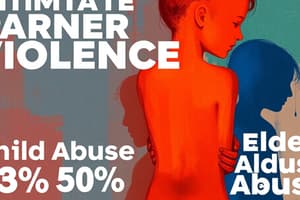Podcast
Questions and Answers
Which forms of abuse can be classified as emotional abuse?
Which forms of abuse can be classified as emotional abuse?
- Verbal attacks and threats (correct)
- Forcing someone to have sex
- Hitting and punching
- Restricting access to personal funds
Which region in Canada has the highest rates of intimate partner violence?
Which region in Canada has the highest rates of intimate partner violence?
- Ontario
- British Columbia
- Manitoba
- Nunavut (correct)
What is the primary function of the CTS-2?
What is the primary function of the CTS-2?
- To provide therapy for victims
- To assess cultural differences in abuse
- To measure intimate partner abuse (correct)
- To measure emotional abuse in relationships
What percentage of intimate partner violence is primarily committed by male perpetrators?
What percentage of intimate partner violence is primarily committed by male perpetrators?
In which situation do the rates of intimate partner violence between genders tend to level off?
In which situation do the rates of intimate partner violence between genders tend to level off?
What is the primary focus of therapies aimed at addressing intimate partner violence (IPV)?
What is the primary focus of therapies aimed at addressing intimate partner violence (IPV)?
What is one key characteristic of the cognitive-behavioral therapy (CBT) model used for batterers?
What is one key characteristic of the cognitive-behavioral therapy (CBT) model used for batterers?
Which statement accurately describes the battered woman/man syndrome in legal contexts?
Which statement accurately describes the battered woman/man syndrome in legal contexts?
What is a significant concern related to group therapy for abusers of intimate partner violence?
What is a significant concern related to group therapy for abusers of intimate partner violence?
What cognitive aspect does CBT aim to challenge in batterers?
What cognitive aspect does CBT aim to challenge in batterers?
How does the patriarchal model of intimate partner violence primarily function?
How does the patriarchal model of intimate partner violence primarily function?
What is a key characteristic of the evolutionary model of intimate partner violence?
What is a key characteristic of the evolutionary model of intimate partner violence?
What role do incentive instigators play in intimate partner violence according to the social learning model?
What role do incentive instigators play in intimate partner violence according to the social learning model?
Which phase represents increased conflict before the first assault in the cycle of violence?
Which phase represents increased conflict before the first assault in the cycle of violence?
What is learned helplessness in the context of abusive relationships?
What is learned helplessness in the context of abusive relationships?
Which type of male batterer restricts violence primarily to the home and tends to express remorse?
Which type of male batterer restricts violence primarily to the home and tends to express remorse?
What is a significant factor preventing women from leaving abusive relationships?
What is a significant factor preventing women from leaving abusive relationships?
Which technique is used to prevent repeat abuse through legislative changes?
Which technique is used to prevent repeat abuse through legislative changes?
What does the newly implemented law allowing victims to inquire about someone’s IPV records aim to achieve?
What does the newly implemented law allowing victims to inquire about someone’s IPV records aim to achieve?
How does the social learning theory explain the behavior of individuals raised in violent households?
How does the social learning theory explain the behavior of individuals raised in violent households?
What effect does the 'honeymoon phase' have on the victim in an abusive relationship?
What effect does the 'honeymoon phase' have on the victim in an abusive relationship?
Which batterer type exhibits moderate to severe violence and possesses emotional or psychiatric issues?
Which batterer type exhibits moderate to severe violence and possesses emotional or psychiatric issues?
Which of the following best describes the primary function of mandatory charging policies in intimate partner violence?
Which of the following best describes the primary function of mandatory charging policies in intimate partner violence?
What is a unique threat faced by victims in same-sex relationships during intimate partner violence scenarios?
What is a unique threat faced by victims in same-sex relationships during intimate partner violence scenarios?
Flashcards
What is the CTS-2?
What is the CTS-2?
A tool used to measure the severity of violence experienced by intimate partners, covering different types of abuse like physical assault, psychological manipulation, sexual coercion and financial control.
What is the Power and Control Wheel?
What is the Power and Control Wheel?
A pattern of coercive behaviors used to establish and maintain power and control over a partner. It includes intimidation, emotional abuse, isolation, minimizing, denying, blaming, male privilege, economic abuse, and threats.
What is physical abuse?
What is physical abuse?
This type of abuse involves physical harm, such as hitting, punching, stabbing, burning, or any action causing physical pain.
What is emotional abuse?
What is emotional abuse?
Signup and view all the flashcards
What is sexual abuse?
What is sexual abuse?
Signup and view all the flashcards
Cognitive Behavioral Therapy Model for IPV
Cognitive Behavioral Therapy Model for IPV
Signup and view all the flashcards
Battered Woman/Man Syndrome
Battered Woman/Man Syndrome
Signup and view all the flashcards
The Right to Control
The Right to Control
Signup and view all the flashcards
Challenging Abusive Beliefs
Challenging Abusive Beliefs
Signup and view all the flashcards
Violence as a Solution
Violence as a Solution
Signup and view all the flashcards
Patriarchal Model
Patriarchal Model
Signup and view all the flashcards
Evolutionary Model
Evolutionary Model
Signup and view all the flashcards
Social Learning Model
Social Learning Model
Signup and view all the flashcards
Learned Helplessness
Learned Helplessness
Signup and view all the flashcards
Cycle of Violence
Cycle of Violence
Signup and view all the flashcards
Family-Only Batterer (Type I)
Family-Only Batterer (Type I)
Signup and view all the flashcards
Dysphoric/Borderline Batterer (Type II)
Dysphoric/Borderline Batterer (Type II)
Signup and view all the flashcards
Generally Violent/Antisocial Batterer (Type III)
Generally Violent/Antisocial Batterer (Type III)
Signup and view all the flashcards
Protection Orders
Protection Orders
Signup and view all the flashcards
Mandatory Arrest Policies
Mandatory Arrest Policies
Signup and view all the flashcards
Court-Mandated Treatment
Court-Mandated Treatment
Signup and view all the flashcards
Duluth Model
Duluth Model
Signup and view all the flashcards
Cognitive-Behavioral Therapy (CBT)
Cognitive-Behavioral Therapy (CBT)
Signup and view all the flashcards
Recidivism
Recidivism
Signup and view all the flashcards
Same-Sex Intimate Partner Violence
Same-Sex Intimate Partner Violence
Signup and view all the flashcards
Study Notes
Prevalence of Intimate Partner Violence (IPV)
- High prevalence in Canada, particularly in Manitoba and Saskatchewan.
- Lowest rates in British Columbia, Prince Edward Island, and Ontario.
- Nunavut, Northwest Territories, and Yukon have the highest overall rates.
Forms of Abuse
- Physical: hitting, punching, stabbing, burning.
- Sexual: forcing sexual activity.
- Financial: restricting access to funds, stealing pay.
- Emotional: verbal attacks, degradation, threats against family members/pets.
- Power and Control Wheel: identifies 8 control strategies, including intimidation, emotional abuse, isolation, minimizing/denying/blaming, using children, exploiting male privilege, economic abuse, and threats. Differences exist between heterosexual and same-sex relationships.
- CTS-2 (Conflict Tactics Scale): measures different abuse levels, including physical assault, sexual coercion, and psychological aggression.
Perpetrators and Victims
- Predominantly, men are perpetrators and women are victims of IPV.
- Rates of male-to-male and female-to-female IPV are possibly higher than perceived, although male perpetration is still more common.
- Indigenous women are substantially more likely to experience IPV and lethal violence, both in dating and non-IPV situations.
Theoretical Models of IPV
- Patriarchal Model: cultural beliefs support male dominance, correlated with higher rates of spousal assault.
- Evolutionary Model: abuse evolved as a tactic to maintain control and secure relationship resources.
- Social Learning Model: acquired behaviors (violence) are likely reinforced by social factors (social learning theory).
- Aversive and Incentive Instigators: factors that trigger violence in perpetrators, and how consequences (external/self) can decrease violence.
Battered Woman/Man Syndrome and Reasons for Staying/Returning
- Cycle of Violence: a repeating pattern of tension-building, acting-out, and honeymoon phases.
- Learned Helplessness: persistent abuse creates a sense of powerlessness.
- Reasons for Returning: fear, hopelessness, lack of resources (money, shelter, familial support), optimism, hope the abuser will change, concern for children.
- Resources available for victims need to be known.
Typology of Male Batterers
- Family-Only (Type I): limited to the home, least violence, may show remorse.
- Dysphoric/Borderline (Type II): some extra-familial activity, moderate to severe violence, emotional/psychiatric problems (jealousy, impulsivity).
- Violent/Antisocial (Type III): aggressive across settings, moderate to severe violence, antisocial/narcissistic traits, substance abuse.
Same-Sex Violence
- Similar dynamics in same-sex relationships.
- Abusers may use unique threats, such as sexuality disclosure; social context matters.
Legislative Changes and Recidivism
- Protection Orders: can be difficult to obtain and enforce, but restrictions on firearms are possible.
- New Laws: allowing inquiry about potential abuse.
- Mandatory Charging Policies: allowing police to forcibly remove the abuser and seek court-mandated treatment.
- Court-Mandated Treatment: Duluth model (challenging patriarchal beliefs), CBT (learning and reinforcement behavior modification), and Correctional Service of Canada programs. (70% dropout rate in some group settings)
Legal Defense
- Battered Woman/Man syndrome is presented as a mitigating factor in court cases involving killing an abuser, NOT a clear defense similar to NCRMD (Not Criminally Responsible on account of a Mental Disorder)
- Various elements, such as learned helplessness and hypervigilance, are considered in such cases.
Studying That Suits You
Use AI to generate personalized quizzes and flashcards to suit your learning preferences.




